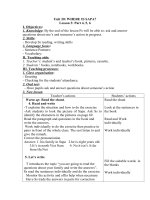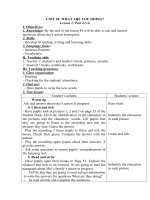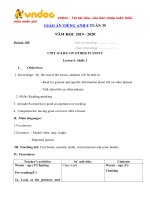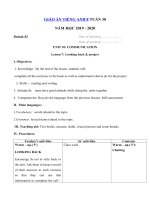Tải Giáo án tiếng Anh lớp 11 Tuần 11 sách mới - Giáo án điện tử môn tiếng Anh 11 theo tuần
Bạn đang xem bản rút gọn của tài liệu. Xem và tải ngay bản đầy đủ của tài liệu tại đây (107.07 KB, 9 trang )
<span class='text_page_counter'>(1)</span><div class='page_container' data-page=1>
<b>GIÁO ÁN TIẾNG ANH LỚP 11 TUẦN 11</b>
<b>NĂM 2019 - 2020</b>
Date of preparation:
Date of signing: <b> </b>
<b>Period 31: </b>
<b>UNIT 4: CARING FOR THOSE IN NEED</b>
<b>Part 2: Language</b>
<b>I. Objectives</b>
By the end of the lesson, students will be able to:
<b>1. Knowledge</b>
- enrich their vocabulary with words or phrases related to people with disabilities and how to
support them
- know the elision of weak vowels before /l/, /n/ and /r/
- know how to use and distinguish between the past simple and present perfect
<b>2. Skills</b>
- Listening, reading
<b>3. Attitude</b>
- have responsible attitude towards their study.
<b>II. Teaching method: Integrated, mainly communicative</b>
<b>III. Teaching aids</b>
- CD & CD player, board, chalks, textbook and notebook.
<b>IV. Procedure</b>
<b>1. Class organization: </b>
Date Period Class Attendance Absentees/Notes
….. __ / __ / __ …. / ….
<b>2. Previous lesson check: </b>
- activity 3.
<b>3. New lesson:</b>
T’s and Ss’Activities Knowledge
Warm-up:
Ask and Answer <i>How do you perceive and treat people with </i>
</div>
<span class='text_page_counter'>(2)</span><div class='page_container' data-page=2>
T: Ask sts work individually, read each of the
words and think about its word class.
Guide sts that they should read each explanation
and decide if it defines a verb, noun or
adjective.
Call some sts to give out the answer
Have two sts write the answers on bb.
Check & give remarks
Ss: Work individually, read each of the words
and think about its word class.
Some sts to give out the answer
Two sts write the answers on bb.
Listen
T: Go through the words in the box and check
sts’ understanding.
Ask sts to complete the sentences individually.
Check the completed sentences as a class,
making sure that all sts have the right answers.
T: Explain elision of vowels, especially the schwa
sound/ə/. Elision is not mandatory. Weak vowels
are sometimes elided before the sounds/l/, /n/
and/r/ to speed up or simplify the pronunciation
of a word.
Play the recording for sts to listen and follow.
Play the recording again for sts to repeat chorally
and individually.
Help sts to distinguish between the pronunciation
without elision and the pronunciation with
elision.
Ask sts to work in pairs, taking turns to
pronounce the words twice- with and without
A. VOCABULARY:
1. Activity 1:
1. b;
2. e;
3. d;
4. c;
5. a
2. Activity 2:
1. blind
2. cognitive
3. donation
4. physical
5. hearing
</div>
<span class='text_page_counter'>(3)</span><div class='page_container' data-page=3>
elision of weak vowels.
T: Ask sts to read the instructions and explain the
task.
Ask them to read the sentences, focusing on the
words in bold and have sts repeat.
Play the recording for sts to repeat once or twice.
Extend this task by having sts take turns reading
each of the sentences twice- with and without
elisions of weak vowels.
Ss: Read the instructions and explain the task.
Read the sentences, focusing on the words in
bold and have sts repeat.
Listen
Take turns reading each of the sentences
twice-with and twice-without elisions of weak vowels.
T: Tell sts that the activity focuses on the past
simple and the present perfect tense of verbs.
Ask if they can remember any rules for the use of
the past simple and the present perfect that they
have learnt in the lower grades.
Have sts work in pairs to figure the answers.
Monitor the activity and help sts, if necessary.
Remind sts to pay attention to the adverbs of time
when they choose the correct form of the verbs.
Remind sts of the past participle forms of regular
verbs and irregular verbs.
Check answers as a class.
T: Tell sts that the activity focuses on the correct
form of the verbs- the past simple or the present
perfect.
Let sts work in pairs to give answers. Observe
2. Activity 2:
Textbook, page 40
C. GRAMMAR
1. Activity 1:
1. launched
2. decided
3. invited
4. have completely changed
5. have collected
</div>
<span class='text_page_counter'>(4)</span><div class='page_container' data-page=4>
and help when and where necessary.
Remind sts to pay attention to the adverbs of time
when they choose the correct form of the verbs.
Check sts’ answers by asking individual sts to
take turns reading aloud each of the sentences.
4. presented
5. have donated
6. talked
7. have sent
<i>8. visited</i>
<b>4. Consolidation: </b>
- Summarize the main points:
- words or phrases related to people with disabilities and how to support them
- the elision of weak vowels before /l/, /n/ and /r/
- the past simple and present perfect
Ask sts:
<i>What have you learnt today?</i>
<i>What can you do now?</i>
Expected answer
<i>I can talk about people with disabilities and how to help people in need. I can use the past </i>
<i>simple and the present perfect to talk about past actions with time expressions. I can </i>
<i>recognize and pronounce words with elision of vowels.</i>
<b>5. Homework: </b>
- practice the tasks.
- prepare for the next lesson
<b></b>
---o0o---Date of preparation:
Date of signing: <b> </b>
<b>Period 32: </b>
<b>UNIT 4: CARING FOR THOSE IN NEED</b>
<b>Part 3: Reading</b>
<b>I. Objectives</b>
By the end of the lesson, students will be able to:
<b>1. Knowledge</b>
- get information about how to help people in need.
- know words and phrases related to attitudes to disabled people and community activities.
<b>2. Skills</b>
- develop reading skill: scanning, skimming
</div>
<span class='text_page_counter'>(5)</span><div class='page_container' data-page=5>
- have responsible attitude towards helping people with disabilities.
<b>II. Teaching method: Integrated, mainly communicative</b>
<b>III. Teaching aids</b>
- board, chalks, textbook and notebook.
<b>IV. Procedure</b>
<b>1. Class organization: </b>
Date Period Class Attendance Absentees/Notes
….. __ / __ / __ …. / ….
<b>2. Previous lesson check: </b>
- distinguish the past simple and the present perfect.
<b>3. New lesson:</b>
T’s and Ss’Activities Knowledge
T: Shows the symbols used to indicate access
for people with disabilities.
Provide sts with some information about
improving accessibility for disabled people.
Have sts look at the symbols and work in
groups to compare the answers. Encourage sts
to explain and give reasons for their answers.
Correct answers as a class & have sts guess the
possible content of the reading text.
T: Ask sts to work individually, read the words
and phrases in the columns, then discuss and
find the meaning of each of them(a-e). provide
help, if necessary. Explain the meaning further
and give examples. Check answers as a class.
1. Activity 1:
Ss: Look at the symbols and work in groups to
compare the answers. Encourage sts to explain
and give reasons for their answers.
<i>Keys suggested</i>
<i>People with mobility impairments/ </i>
<i>disabilities.</i>
<i>People with visual impairments/ disabilities.</i>
<i>People with hearing impairments/ disabilities.</i>
<i>People with speech impairments/ disabilities.</i>
2. Activity 2:
Ss: Work individually, read the words and
phrases in the columns, then discuss and
find the meaning of each of them(a-e).
<i>Keys suggested</i>
</div>
<span class='text_page_counter'>(6)</span><div class='page_container' data-page=6>
T: Tell sts that the activity focuses on reading
for general ideas and have them read the
headings quickly before the texts that follows.
Explain to sts that repeated and similar
vocabulary can form a vocabulary chain in a
paragraph, and consequently help express the
main idea of the paragraph.
Have sts skim the text individually to choose
the best heading for each paragraph. Then sts
can check their answers with a partner.
Check answers as a class and write them on the
board. Give feedback.
T: Tell sts that the activity focuses on reading
for specific information and that sts cannot
write more than three words in each blank.
Ask sts to read the passage gain and fill in the
blanks. Remind sts to pay attention to details
like names of schools, classes, activities… and
to the context to identify what kind of words or
phrases are needed.
Have sts write their answer individually and
check with their partner.
Check answers as a class & provide feedback.
T: Put sts in pairs and ask them to discuss the
questions freely:
Ask one or two pairs to report the discussion
results to the class.
Give remarks
3. Activity 3:
Ss: Listen
Skim the text individually to choose the best
heading for each paragraph
Write the answers on the board.
<i>Keys suggested. </i>
1. b;
2. c;
3.a
4. Activity 4:
Ss: Read the passage gain and fill in the
blanks.
Pay attention to details like names of schools,
classes, activities… and to the context to
identify what kind of words or phrases are
needed.
Write their answer individually and check
with their partner.
<i>Keys suggested. </i>
1. students with disabilities
2. record popular books
3. participating fully in
4. ‘record-breaking’
5. this Christmas unforgettable
Activity 5:
Ss: Work in pairs and discuss the questions
freely.
</div>
<span class='text_page_counter'>(7)</span><div class='page_container' data-page=7>
Listen
<i>How can you help children with </i>
<i>disabilities in your community?</i>
<b>4. Consolidation: </b>
- Summarize the main points:
+ Reading for general ideas and specific information about helping people disabilities.
<i>+ Lexical items: disability, blind, deaf, dumb, get around, integrate, campaign, charity, </i>
<i>donate.</i>
<b>5. Homework: </b>
- practice the tasks.
- prepare for the next lesson
<b></b>
---o0o---Date of preparation:
Date of signing: <b> </b>
<b>Period 33: </b>
<b>UNIT 4: CARING FOR THOSE IN NEED</b>
<b>Part 4: Speaking</b>
<b>I. Objectives</b>
By the end of the lesson, students will be able to:
<b>1. Knowledge</b>
- describe reasons for getting involved in donating to charities and supporting disabled
children
<i>- Lexical items: disability, blind, deaf, dumb, get around, integrate, campaign, charity, </i>
<i>donate, coach, cognitive impairment.</i>
<b>2. Skills</b>
- Speaking: discussing and interviewing
<b>3. Attitude</b>
- have responsible attitude towards helping people with disabilities.
<b>II. Teaching method: Integrated, mainly communicative</b>
<b>III. Teaching aids</b>
- board, chalks, textbook and notebook.
<b>IV. Procedure</b>
<b>1. Class organization: </b>
Date Period Class Attendance Absentees/Notes
</div>
<span class='text_page_counter'>(8)</span><div class='page_container' data-page=8>
<b>2. Previous lesson check: </b>
- activity 5.
<b>3. New lesson:</b>
T’s and Ss’Activities Knowledge
<i>T: Write Get involved! On the board and give sts </i>
time to discuss the phrase.
Ask:
Explain the activity aims to differentiate between
the notions “reason” and “activity”
Have sts read the phrases, and check answers as a
class.
T: Explain the context and ask sts to read through
the phrases in the box.
Have sts work in pairs to fill the gaps in the
interview.
Check answers as a class and give feedback.
Allow enough time for sts to read the interview
individually before they practice in pairs.
Monitor the activity and select some pairs to
role-play the conversation in front of the class.
Activity 1:
Ss: Answer
Listen
Read the phrases.
<i>Have you ever taken part in campaigns to </i>
<i>help people with disabilities?</i>
<i>Why do you volunteer to help people?</i>
<i>How can you help people in need?</i>
<i>Keys suggested.</i>
1. R; 2. A; 3. R; 4. R; 5.A
Activity 2:
Ss: Read through the phrases in the box.
Work in pairs to fill the gaps in the
interview.
Listen
Read the interview individually before they
practice in pairs.
Role-play the conversation in front of the
class.
<i>Keys suggested.</i>
1. volunteer position
2. special school
3. change people’s lives
4. in the past
</div>
<span class='text_page_counter'>(9)</span><div class='page_container' data-page=9>
T: Ask sts to read the instructions carefully, then
have them go through the information about
Nguyen Dinh Chieu School and Nhan Chinh
School.
Ask sts to prepare the reason why they want to
volunteer, and what they can do. Tell sts that they
can use suggestions in Activity 1.
Have sts work in pairs to share their ideas and
suggestions.
Choose one or two pairs to role-play their
conversation in front of the class.
Activity 3:
Ss: Read the instructions carefully, then have
them go through the information about
Nguyen Dinh Chieu School and Nhan Chinh
School.
Prepare the reason why they want to
volunteer, and what they can do.
Work in pairs to share their ideas and
suggestions.
One or two pairs to role-play their
conversation in front of the class.
<b>4. Consolidation: </b>
<b>- Summarize the main points: </b>
- reasons for getting involved in donating to charities and supporting disabled children, what
people can do for the society and people with disabilities.
<i>- Lexical items: disability, blind, deaf, dumb, get around, integrate, campaign, charity, </i>
<i>donate, coach, cognitive impairment.</i>
<b>5. Homework: </b>
- practice the tasks.
- prepare for the next lesson
Mời bạn đọc tham khảo thêm tài liệu Tiếng Anh lớp 11 tại đây:
Bài tập Tiếng Anh lớp 11 theo từng Unit:
Bài tập Tiếng Anh lớp 11 nâng cao:
</div>
<!--links-->









